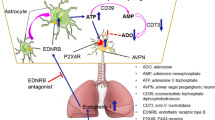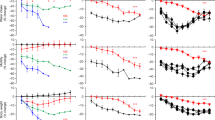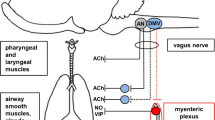Abstract
Central neuronal interactions may contribute to up regulation of cough in subjects with rhinitis. Previously we have shown that noxious stimulation of the nose induces considerable Fos-like immunoreactivity (FLI) in the solitary nuclei and the region of ventral respiratory group and these neurons are involved in the cough pattern generator. Recent study addressed the question, which additional groups are activated in model of trigeminal hyperresponsiveness and whether some of them might also cooperate with cough pattern gating areas. 24 guinea pigs were sensitized with intraperitoneal ovalbumin (OVA) and later were once weekly challenged with intranasal OVA to develop the neural hyperresponsiveness, 12 animals were left unsensitized. The nasal symptom score was evaluated after each challenge. Finally, animals were anaesthetized and the latest challenges with nasal OVA, capsaicin and saline were applied to induce c-Fos expression in designed groups. Following the survival time animals were deeply anaesthetized, exsanguinated, and transcardially perfused with heparinised saline (200 ml) and paraformaldehyde fixation (200 ml). The brainstems were removed, postfixed, and brainstem slices were processed immunohistochemically (c-Fos, Calbiochem, SR). FLI at the level of obex and areas relative to the obex was analyzed. In all groups (excluding the saline group) the FLI was detected bilaterally in the trigeminal complex, nuclei of solitary tract, lateral reticular and nucleus ambiguus. There were no differences between the OVA and capsaicin groups. Count of Fos-positive neurons within the trigeminal complex does not correlate with the magnitude of clinical symptoms, which gradually increased each week in OVA induced model of hyperresponsiveness. Whereas trigeminal hyperresponsiveness contributes to the up-regulation of cough in animal models, it does not induce any additional neuronal FLI at the middle medulla than observed in naive animals.
Similar content being viewed by others
References
Bonham A.C., Sekizawa S., Chen C.Y. & Joad J.P. 2006. Plasticity of brainstem mechanisms of cough. Respir. Physiol. Neurobiol. 152(3): 312–319. DOI:10.1016/j.resp.2006.02.010
Brozmanova M., Čalkovsky V., Plevkova J. & Tatar M. 2004. Effects of inhaled corticosteroids on cough in awake guinea pigs with experimental allergic rhinitis — the first experience. J. Physiol. Pharmacol. 55(Suppl. 3): 23–30.
Brozmanova M., Plevkova J., Tatar M. & Kollarik M. 2008. Cough reflex sensitivity is increased in the guinea pig model of allergic rhinitis. J. Physiol. Pharmacol. 59(Suppl. 6): 153–161.
Cho Y., Park S., Lee C., Yoo B. & Moon H. 2003. Elevated substance P levels in nasal lavage fluids from patients with chronic nonproductive cough and increased cough sensitivity to inhaled capsaicin. J. Allergy Clin. Immunol. 112(4): 695–701.
Curatolo M., Arendt-Nielsen L. & Petersen-Felix S. 2004. Evidence, mechanisms, and clinical implications of central hypersensitivity in chronic pain after whiplash injury. Clin. J. Pain 20(6): 469–476.
Curran T. & Morgan J. 1995. Fos: an immediate-early transcription factor in neurons. J. Neurobiol. 26(3): 403–412.
Hellings P.W. & Hens G. 2009. Rhinosinusitis and the lower airways. Immunol. Allergy Clin. Nort. Am. 29(4): 733–740. DOI: 10.1016/j.iac.2009.08.001
Plevkova J., Antosiewicz J., Varechova S., Poliacek I., Tatar M., Jakus J. & Pokorski M. 2009. Convergence of nasal and tracheal neural pathways in modulating the cough response in guinea pigs. J. Physiol. Pharmacol. 60(2): 89–93.
Plevkova J., Kollarik M., Brozmanova M., Revallo M., Varechova S. & Tatar M. 2004. Modulation of experimentally-induced cough by stimulation of nasal mucosa in cats and guinea pigs. Respir. Physiol. Neurobiol. 142(2–3): 225–235. DOI: 10.1016/j.resp.2004.06
Plevkova J., Poliacek I., Antosiewicz J., Adamkov M., Jakus J. & Tatar M. 2010. Intranasal TRPV1 agonist capsaicin challenge and its effect on c-fos expression in the guinea pig brainstem. Respir. Physiol. Neurobiol. DOI: 10.1016/j.resp.2010.05.015
Pratter M.R. & Abouzhaeib W. 2006. Make the cough go away. Chest 129: 1121–1122. DOI: 10.1378/chest.129.5.1121
Sarin S., Undem B., Sanico A. & Togias A. 2006. The role of the nervous system in rhinitis. J. Allergy Clin. Immunol. 118(5): 999–1016. DOI: 10.1097/ACI.0b013e328334f5de
Sekizawa S. & Tsubone H. 1996. Nasal receptors responding to noxious chemical irritants. Respir. Physiol. 96: 37–48. DOI: 10.1016/0034-5687(94)90104-X
Taylor-Clark T.E., Kollarik M., MacGlashan D. & Undem B. 2005. Nasal sensory nerve populations responding to histamine and capsaicin. J. Allergy Clin. Immunol. 116(6): 1282–1288. DOI: 10.1016/j.jaci.2005.08.043
Taylor-Clark T.E., Nassenstein C. & Undem B.J. 2008. Leukotriene D4 increase the excitability of capsaicin sensitive nerves to electrical and chemical stimuli. Brit. J. Pharmacol. 154(6): 1359–1368. DOI: 10.1038/bjp.2008.196
Undem B., Kajekar R., Hunter D. & Myers A. 2000. Neural integration and allergic disease. J. Allergy Clin. Immunol. 106(5 part 2): S213–S220. DOI: 10.1067/mai.2000.110153
Underwood S., Foster M., Raeburn D., Bottoms S. & Karlsson J.A. 1995. Time course of antigen — induced airway inflamation in the guinea-pig and its relationship to airway hyperresponsiveness. Eur. Respir. J. 8: 2104–2113. DOI: 10.1183109031936.95.08122104
Voitenko L.P. & Marlinskij V.V. 1993. Stereotaxic atlas of the guinea pig brainstem. Neurophysiology 25(1): 52–77. DOI: 10.1007/BF01053633
Wallois F., Bodineau L., Macron J.M., Marlot D. & Duron B. 1997. Role of respiratory and non respiratory neurones in the region of the NTS in the elaboration of the sneezing reflex in cat. Brain Res. 768(1–2): 71–85.
Author information
Authors and Affiliations
Corresponding author
Rights and permissions
About this article
Cite this article
Plevková, J., Poliaček, I., Adamkov, M. et al. Brainstem neuronal populations activated in the model of ovalbumine induced allergic rhinitis in guinea pigs — the c-Fos study. Biologia 66, 922–927 (2011). https://doi.org/10.2478/s11756-011-0096-0
Received:
Accepted:
Published:
Issue Date:
DOI: https://doi.org/10.2478/s11756-011-0096-0




